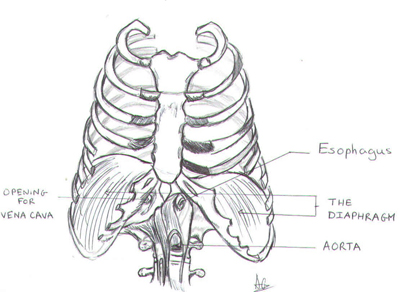 The diaphragm muscle is located right underneath the lungs and heart. Each time you take a breath in, it pushes down the content of the abdominal cavity (most of the organs) and allows the lungs to fill up with air. Beside this function, the esophagus, the aorta and the vein cava go through it, not to mention all the tiny vessels for lymph drainage. Therefore, it has a huge impact on the journey of healthy blood, of toxic waste and the circulation of the alimentary bowl.
The diaphragm muscle is located right underneath the lungs and heart. Each time you take a breath in, it pushes down the content of the abdominal cavity (most of the organs) and allows the lungs to fill up with air. Beside this function, the esophagus, the aorta and the vein cava go through it, not to mention all the tiny vessels for lymph drainage. Therefore, it has a huge impact on the journey of healthy blood, of toxic waste and the circulation of the alimentary bowl.
Anything happening at the diaphragm can cause disease. In many ways, the diaphragm is a pump that, while controlling breathing, also distributes all the liquids to all parts of the body, and back to the heart.
What happens a lot these days, due to our environment and pretty common working conditions (sitting most of the time), is that the rib cage collapses. The diaphragm is a muscle. The less you use it, the more atrophic and flabby it gets. It looses is strength and fails to maintain healthy tension around the aorta, vein cava and esophagus. Not only does it affect breathing and lung capacity but it will impede digestion, blood circulation and lymphatic drainage.
As an alternative to using the diaphragm, people will, in general, use more of the superficial muscles in the neck and chest. However, these muscles are not favorable to optimal breathing. They are accessory muscles, meant to be used for extra air, not as primary breathing muscles. Improper use of the muscles on the top of the ribcage will lead to tight shoulders, neck stiffness and eventually pain.
How to Breathe
Now, how to breathe, in a way that helps your body? In a way that doesn’t over stress the neck muscles and allows proper flow of liquids through the diaphragm, from the thoracic cavity to the abdominal cavity and vice versa?
You need to activate the pump at the diaphragm. Which each breath in, the diaphragm pushes down and the pelvic floor (nice and relaxed) should follow the whole movement, grounding you to the earth. Through this pushing action the rib cage expands, the ribs open up on the sides and the belly button goes forward. Which each breath out, the pressure returns to the lungs and all the other parts return to their original position. This will provide proper usage of the diaphragm and guaranty integrity of all the systems passing through.
